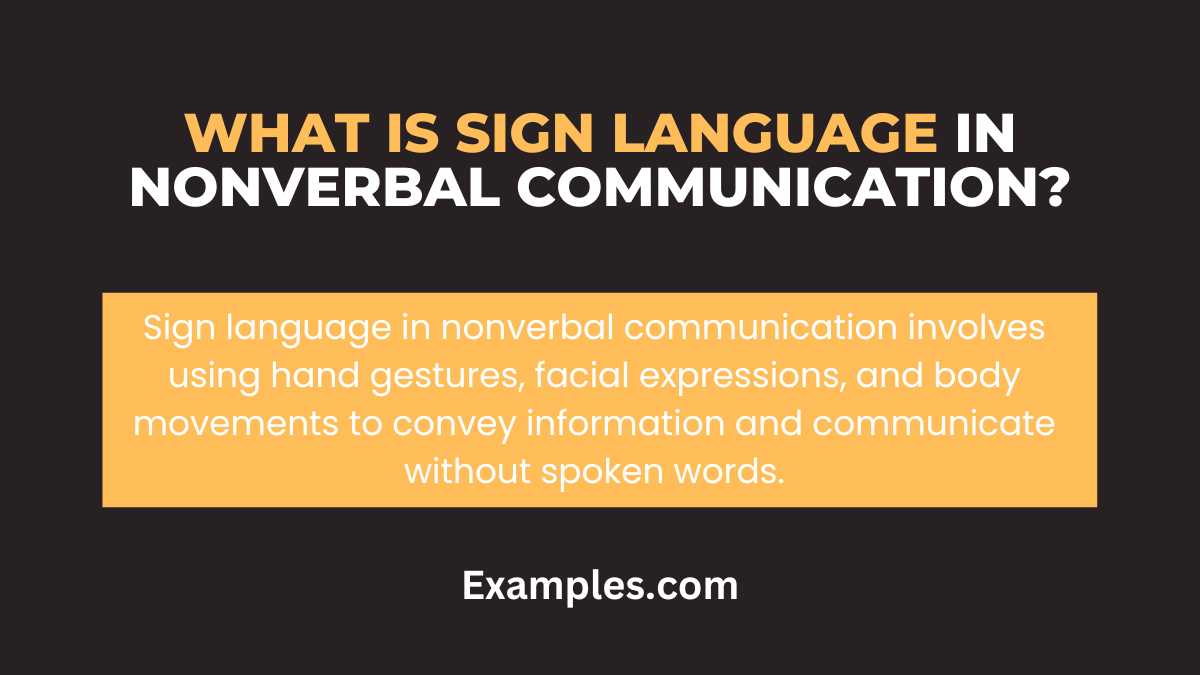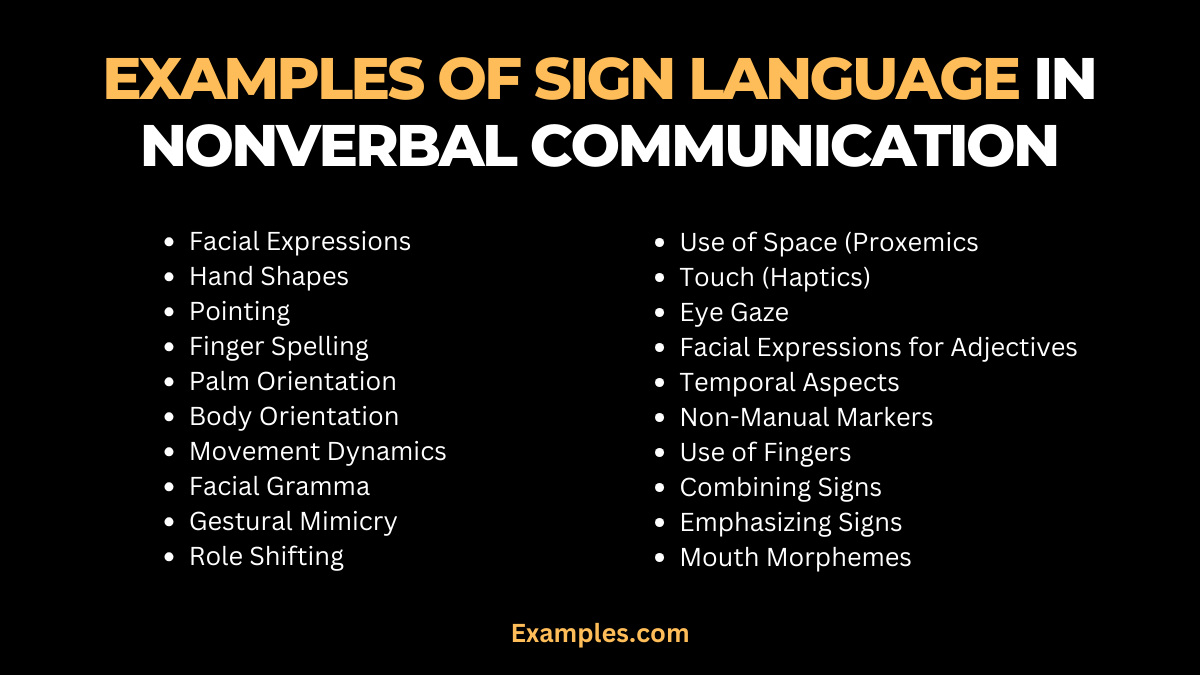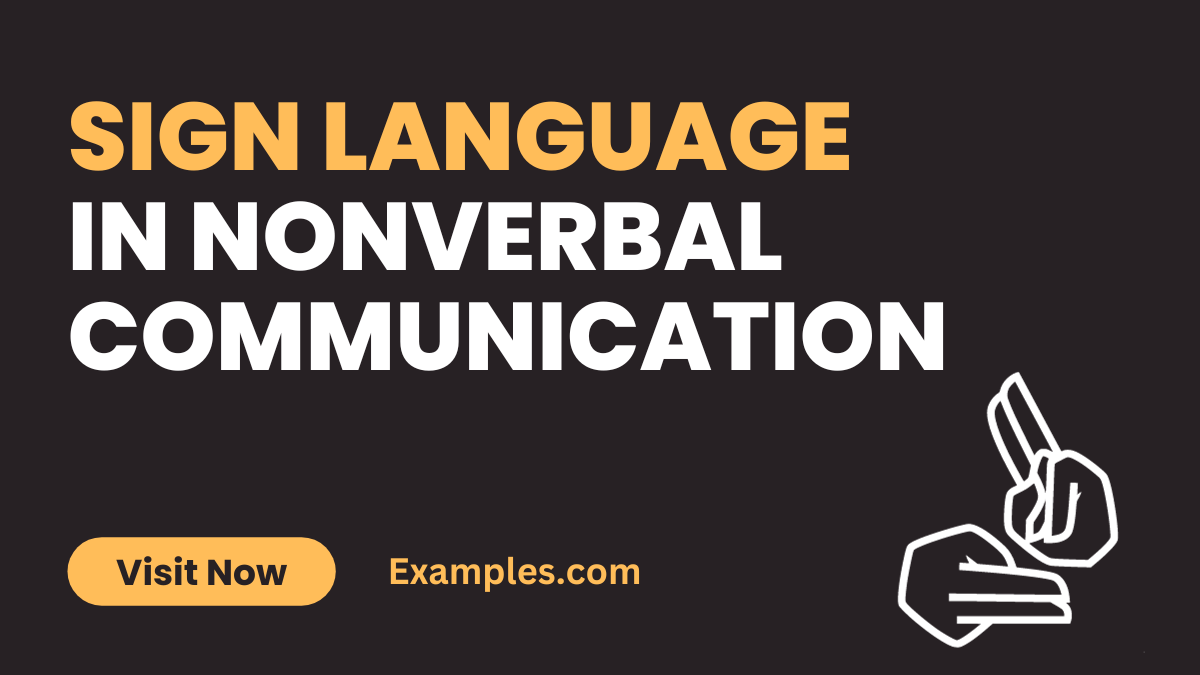19+ Sign Language in Nonverbal Communication Examples
Discover the intricate world of nonverbal communication through our detailed guide on Sign Language. Learn how to effectively convey emotions and ideas without uttering a single word. This guide will walk you through various communication examples, offering a comprehensive understanding of this silent yet powerful language.
What is Sign Language in Nonverbal Communication?

Sign Language is a vital part of nonverbal communication, enabling individuals to express thoughts, emotions, and intentions through structured hand gestures, facial expressions, and body language. It transcends verbal boundaries, offering a universal medium for interaction.
Examples of Sign Language in Nonverbal Communication

Sign language, a vital aspect of nonverbal communication, showcases diverse ways individuals express thoughts and emotions without words. Embracing the types of nonverbal communication, this article delves into the unique characteristics of sign language. From facial expressions to body gestures, sign language enriches our understanding of silent communication.
Facial Expressions
Facial expressions are a vital aspect of nonverbal communication, reflecting emotions and intentions without words. They include various movements and positions of facial muscles, such as smiling, frowning, or raising eyebrows. These expressions convey feelings like happiness, anger, surprise, or sadness, and are universally recognized across different cultures. Understanding facial expressions enhances interpersonal communication, as they often reveal true emotions that words might not express.
How to Use: To effectively use facial expressions in communication, be mindful of how your expressions align with your words. A genuine smile, for instance, can enhance a positive message.
Hand Shapes
Hand shapes form an essential part of gestures in nonverbal communication. They can be used to convey specific messages or emotions, such as a thumbs-up for approval or a clenched fist to express anger or solidarity. Different cultures attribute various meanings to hand shapes, making them a versatile tool in nonverbal communication. These gestures are particularly significant in contexts where verbal communication is not possible or is limited.
How to Use: Use hand shapes deliberately to complement or emphasize your verbal messages. For example, an open hand can signify openness or peace during a conversation.
Pointing
Pointing is a directional gesture where a finger, hand, or other body part indicates a direction, object, or person. It is a fundamental aspect of nonverbal communication, used to draw attention or specify a location or item. While pointing is a common gesture, its social acceptability varies across cultures. In some societies, pointing, especially with a finger, can be considered rude.
How to Use: Utilize pointing cautiously, ensuring it is culturally appropriate. Pointing can be helpful to direct attention in a group or highlight specific objects during a presentation.
Finger Spelling
Finger spelling is a method of spelling words using hand movements and is a part of sign language, a critical form of nonverbal communication. Each letter of the alphabet has a corresponding hand shape and position. Finger spelling is primarily used to spell out names, places, or words that do not have established signs. It’s an essential tool for communicating complex concepts or proper nouns in sign language.
How to Use: Incorporate finger spelling to spell out specific terms or names that do not have direct signs in sign language conversations.
Palm Orientation
Palm orientation refers to the direction in which the palm faces during hand gestures and is a subtle yet significant element of nonverbal communication. It can change the meaning of a gesture; for example, an open palm facing upwards can signify a request or offering, while facing downwards may signify dominance or stopping. Palm orientation is also crucial in sign languages, where different orientations can convey different meanings.
How to Use: Be conscious of your palm orientation when making gestures, as it can significantly alter the message you intend to convey. For instance, use an upward-facing palm to appear more welcoming and open.
Body Orientation
Body Orientation in Nonverbal Communication refers to the way individuals position their bodies in relation to others. This aspect is crucial as it can indicate interest, attention, or even aggression. For example, facing someone directly can signify engagement, while turning away might imply disinterest or discomfort.
How to Use: To effectively use body orientation, consciously position yourself to reflect your engagement and interest in the conversation. Align your body towards the person you’re communicating with to demonstrate attention.
Movement Dynamics
Movement Dynamics in Nonverbal Communication encompasses the way people move their bodies, including the speed and fluidity of movements. Quick, sharp movements might convey excitement or nervousness, whereas slower movements often reflect calmness or solemnity.
How to Use: Incorporate movement dynamics by being aware of how your movements can convey emotions. Use deliberate and controlled movements to exude confidence and calmness.
Facial Grammar
Facial Grammar is a vital component of Facial Expressions in Nonverbal Communication. It involves the use of facial muscles to convey emotions, intentions, or reactions. A smile can signify happiness, while a frown might indicate disapproval or sadness.
How to Use: To utilize facial grammar effectively, be mindful of your facial expressions and ensure they align with your intended message. A genuine smile, for example, can enhance positive communication.
Gestural Mimicry
Gestural Mimicry in Nonverbal Communication refers to the unconscious imitation of another person’s gestures and body language. This mimicry can create a sense of empathy and rapport. For instance, nodding when someone else nods can create a connection.
How to Use: Use gestural mimicry to build rapport and empathy in interactions. Subtly mirroring the other person’s gestures can make them feel understood and connected.
Role Shifting
Role Shifting in Nonverbal Communication involves changing physical position or posture to indicate a change in the speaker’s perspective or role. For example, a storyteller might shift positions to represent different characters.
How to Use: To apply role shifting, change your position or posture to signal a change in perspective or to emphasize different points in your narrative. This helps in keeping the audience engaged and clarifying different aspects of the conversation.
Use of Space (Proxemics) in Nonverbal Communication
Space in nonverbal communication, also known as proxemics, involves the physical distance between individuals during interactions. This aspect of nonverbal communication is crucial in conveying attitudes and feelings towards others. Different cultures have varying norms regarding personal space, which can influence social and business interactions.
How to use it: Maintain appropriate distances based on cultural norms and relationship contexts. Close proximity can signify intimacy, while more distance may convey formality or detachment.
Touch (Haptics) in Nonverbal Communication
Touch, or haptics, is a significant form of nonverbal communication that varies greatly across different cultures. It encompasses everything from handshakes to hugs and can convey a wide range of emotions, including support, aggression, affection, and dominance.
How to use it: Use touch appropriately to convey the intended message, respecting personal and cultural boundaries. A handshake can establish trust, while a gentle pat can show support or comfort.
Eye Gaze in Nonverbal Communication
Eye gaze in nonverbal communication involves where and how long one looks at someone during interaction. It is a powerful tool in conveying interest, attention, affection, or aggression. Sustained eye contact can demonstrate confidence and interest, while avoiding eye contact might signal discomfort or disinterest.
How to use it: Employ eye contact to establish connection and demonstrate attentiveness. However, be mindful of the intensity and duration to avoid discomfort or misinterpretation.
Facial Expressions for Adjectives
Facial expressions are key in conveying emotions nonverbally. They can be particularly effective in expressing adjectives, such as happiness, sadness, surprise, or anger. These expressions are often universal and are crucial in conveying feelings without words.
How to use it: Utilize facial expressions to enhance verbal communication. A smile can convey friendliness, while a frown can express disagreement or concern.
Temporal Aspects
Temporal aspects, or chronemics, refer to the use of time in nonverbal communication. This includes punctuality, the amount of time spent on events, and the speed of speech. Time perceptions vary culturally and can communicate values and attitudes.
How to use it: Be punctual and mindful of time management to convey respect and professionalism. Adjust your timing and speech speed to match the context and cultural expectations.
Non-Manual Markers
Non-manual markers in sign language involve facial expressions, head movements, and body posture to convey meaning, much like Facial Expressions in Nonverbal Communication. These markers can indicate question types, emotional tones, and grammatical structures, complementing the manual signs. They are crucial in providing context and emotional depth to conversations.
How to Use: Utilize facial expressions and body gestures to add meaning and emotion to signs, enhancing the clarity and impact of your communication.
Use of Fingers
The use of fingers in sign language involves specific movements and positions to represent different concepts, letters, or words, akin to Gestures in Nonverbal Communication. This precise finger articulation is fundamental for conveying specific messages and is a key component of the language’s expressiveness.
How to Use: Master and apply finger positions and movements accurately to express specific ideas and ensure clear communication in sign language.
Combining Signs
Combining signs in sign language involves merging different signs to form phrases or sentences. This practice is similar to constructing sentences in spoken language and essential for fluent communication. Effective combination of signs allows for the expression of complex ideas and narratives.
How to Use: Blend individual signs seamlessly to create meaningful sentences or phrases, enhancing the flow and coherence of sign language communication.
Emphasizing Signs
Emphasizing signs in sign language means altering the sign’s speed, force, or size to convey emphasis or intensity, similar to accenting in spoken language. This technique can significantly impact the conveyed message’s emotional tone and urgency.
How to Use: Modify the intensity or size of signs to highlight important information or express strong emotions effectively in sign language.
Mouth Morphemes
Mouth morphemes in sign language are mouth movements or shapes that accompany signs, contributing additional meaning, much like Paralanguage (Vocalics) in Nonverbal Communication. They can indicate adjectives, adverbs, or other grammatical aspects, adding layers of meaning beyond manual signs.
How to Use: Pair specific mouth movements with manual signs to enhance the meaning and grammatical accuracy of your sign language communication.
Why is Sign Language Important in Nonverbal Communication?
Sign language plays a crucial role in nonverbal communication, bridging the gap where words fall short. It’s not just a communication tool for the deaf and hard of hearing; it’s a profound form of expression for anyone. The importance of sign language in nonverbal communication lies in its ability to convey complex ideas and emotions through gestures, facial expressions, and body language.
Expressing Unspoken Words: Sign language adds depth to communication by conveying feelings and intentions that might be hard to express verbally.
Inclusivity and Accessibility: It fosters an inclusive environment, making communication accessible to those who rely on nonverbal modes.
Enhancing Communication Clarity: In noisy or quiet environments where verbal communication is challenging, sign language ensures the message is still conveyed.
How to Use Sign Language in Nonverbal Communication?
Using sign language in nonverbal communication requires understanding its nuances and adapting it to various contexts.
Learn the Basics: Start with learning the basic signs, including the alphabet and commonly used phrases.
Pay Attention to Facial Expressions and Body Language: These elements are integral in sign language, adding emotional context and clarity to the signs.
Practice Regularly: Like any language, fluency in sign language comes with regular practice. Engage with sign language users or use resources like online courses and videos.
Role of Sign Language in Nonverbal Communication
The role of sign language in nonverbal communication is multifaceted, extending beyond just an alternative to spoken language.
Cultural Representation: Sign language is not just a method of communication but also a cultural identifier for the deaf community, carrying its history and social norms.
Cognitive and Emotional Development: For children, especially those with hearing impairments, sign language is crucial for cognitive and emotional development. It aids in forming social bonds and expressing thoughts and feelings effectively.
Bridging Communication Gaps: Sign language is a powerful tool in bridging communication gaps, not only for those with hearing impairments but also in situations where verbal communication is not feasible.
Incorporating Nonverbal Communication Examples and understanding Types of Nonverbal Communication, Pictures, Examples can greatly enhance the effectiveness of sign language in everyday communication. Sign language is more than a mere substitute for spoken words; it’s a vibrant, expressive form of nonverbal communication that enriches our interactions and connects us more deeply with one another.
Sign language, as a profound element of nonverbal communication, transcends the realm of the spoken word, offering a rich tapestry of expression through its unique gestures and expressions. Its significance extends beyond the deaf community, serving as a vital tool in diverse communication settings where traditional verbal methods are impractical. The universality and adaptability of sign language make it an indispensable component in the landscape of global communication, fostering inclusivity and understanding across different cultures and situations.



